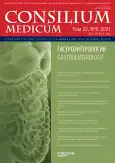Клинико-иммунологический статус пациентов с хроническим гепатитом С на фоне коморбидности
- Авторы: Басина В.В.1, Дземова А.А.1,2, Арсентьева Н.А.2, Новак К.Е.1, Эсауленко Е.В.1,2, Тотолян А.А.2
-
Учреждения:
- ФГБОУ ВО «Санкт-Петербургский государственный педиатрический медицинский университет» Минздрава России
- ФГБУН «Санкт-Петербургский научно-исследовательский институт эпидемиологии и микробиологии им. Пастера» Роспотребнадзора
- Выпуск: Том 23, № 5 (2021)
- Страницы: 428-433
- Раздел: Статьи
- URL: https://journals.rcsi.science/2075-1753/article/view/95489
- DOI: https://doi.org/10.26442/20751753.2021.5.200909
- ID: 95489
Цитировать
Полный текст
Аннотация
Ключевые слова
Полный текст
Открыть статью на сайте журналаОб авторах
Валентина Владимировна Басина
ФГБОУ ВО «Санкт-Петербургский государственный педиатрический медицинский университет» Минздрава России
Email: v.basina@mail.ru
канд. мед. наук, ассистент каф. Санкт-Петербург, Россия
Александра Андреевна Дземова
ФГБОУ ВО «Санкт-Петербургский государственный педиатрический медицинский университет» Минздрава России; ФГБУН «Санкт-Петербургский научно-исследовательский институт эпидемиологии и микробиологии им. Пастера» Роспотребнадзораассистент каф. Санкт-Петербург, Россия
Наталья Александровна Арсентьева
ФГБУН «Санкт-Петербургский научно-исследовательский институт эпидемиологии и микробиологии им. Пастера» Роспотребнадзораканд. биол. наук, ст. науч. сотр. лаб. Санкт-Петербург, Россия
Ксения Егоровна Новак
ФГБОУ ВО «Санкт-Петербургский государственный педиатрический медицинский университет» Минздрава Россииканд. мед. наук, доц. каф. Санкт-Петербург, Россия
Елена Владимировна Эсауленко
ФГБОУ ВО «Санкт-Петербургский государственный педиатрический медицинский университет» Минздрава России; ФГБУН «Санкт-Петербургский научно-исследовательский институт эпидемиологии и микробиологии им. Пастера» Роспотребнадзорад-р мед. наук, проф., зав. каф. Санкт-Петербург, Россия
Арег Артемович Тотолян
ФГБУН «Санкт-Петербургский научно-исследовательский институт эпидемиологии и микробиологии им. Пастера» Роспотребнадзораакад. РАН, д-р мед. наук, проф., зав. лаб. Санкт-Петербург, Россия
Список литературы
- European Association for the Study of the Liver Recommendations on Treatment of Hepatitis C 2015. J Hepatol. 2015;63:199-236.
- Эсауленко Е.В., Новак К.Е., Басина В.В., и др. Распространенность коморбидности при хроническом вирусном гепатите С. Мед. алфавит. 2021;1:66-70
- Heydtmann M, Adams DH. Chemokines in the immunopathogenesis of hepatitis C infection. Hepatology. 2009;49(2):676-88. doi: 10.1002/hep.22763
- Арсентьева Н.А., Семенов А.В., Любимова Н.Е., и др. Содержание цитокинов и хемокинов в плазме крови больных хроническим вирусным гепатитом С. Рос. иммунологический журн. 2015;9(18):83-92
- Арсентьева Н.А., Семенов А.В., Любимова Н.Е., и др. Хемокиновые рецепторы CXCR3 и CCR6 и их лиганды в печени и крови больных хроническим вирусным гепатитом C. Бюл. эксперим. биологии и медицины. 2015;160(8):218-22
- Larrubia J, Benito-Martinez S, Calvino M, et al. Role of chemokines and their receptors in viral persistence and liver damage during chronic hepatitis C virus infection. World J Gastroenterol. 2008;14(47):7149-59. doi: 10.3748/wjg.14.7149
- Cooper C, Galanakis C, Donelle J, et al. HCV-infected individuals have higher prevalence of comorbidity and multimorbidity: a retrospective cohort study. BMC Infect Dis. 2019;19:712. doi: 10.1186/s12879-019-4315-6
- Negro F. Facts and fictions of HCV and comorbidities: steatosis, diabetes mellitus, and cardiovascular diseases. J Hepatol. 2014;61(1):69-78. doi: 10.1016/j.jhep.2014.08.003
- Новак К.Е. Клинико-морфологическая характеристика субкомпенсированного и декомпенсированного цирроза печени вирусной этиологии. Педиатр. 2011;2(2):47-52
- Эсауленко Е.В., Сухорук А.А. Трансплантация в детском возрасте и у взрослых. Педиатр. 2015;6(3):98-103
- Kuna L, Jakab J, Smolic R, et al. HCV Extra hepatic manifestations. J Clin Trans Hepatol. 2019;7(2):172-82. doi: 10.14218/JCTH.2018.00049
- Labenz С, Huber Y, Kalliga E, et al. Predictors of advanced fibrosis in non-cirrhotic non-alcoholic fatty liver disease in Germany. Aliment Pharmacol Ther. 2018;48(10):1109-16. doi: 10.1111/apt.14976
- McPherson S, Gosrani S, Hogg S, et al. Increased cardiovascular risk and reduced quality of life are highly prevalent among individuals with hepatitis C. BMJ Open Gastroenterol. 2020;7(1):000470. D0I:10.1136/bmjgast-2020-000470
- Gonnella D. Type 1 diabetes and MIG. Clin Ther. 2019;170(6):465-71. doi: 10.7417/CT.2019.2177
- Antonelli А, Ferrari S, Corrado A, et al. CXCR3, CXCL10 and type 1 diabetes. Cytokine Growth Factor Rev. 2014;25(1):57-65. doi: 10.1016/j.cytogfr.2014.01.006
- Corrado A, Ferrari S, Ferri C, et al. Type 1 diabetes and (C-X-C motif) ligand (CXCL) 10 chemokine. Clin Ther. 2014;165(2):181-5. doi: 10.7471/CT.2014.1706
- Ferrari S, Ruffilli I, Colaci M, et al. CXCL10 in psoriasis. Adv Med Sci. 2015;60(2):349-54. doi: 10.1016/j.advms.2015.07.011
- Antonelli A, Ferrari S, Giuggioli D, et al. Chemokine (C-X-C motif) ligand (CXCL)10 in autoimmune diseases. Autoimmun Rev. 2014;13(3):272-80. doi: 10.1016/j.autrev.2013.10.010
- Sayed-Ahmed L, Kotb N, El-Serogy H, et al. TNF-alpha and CXCL-10 correlation with insulin resistance in patients with chronic hepatitis C virus infection. Egypt J Immunol. 2010;17(1):101-11
- Hung C-H, Lee C-M, Lu S-N. Hepatitis C virus-associated insulin resistance: pathogenic mechanisms and clinical implications. Expert Rev Anti Infect Ther. 2011;9(5):525-33. doi: 10.1586/eri.11.33
- Liu C, Feng X, Li Q, et al. TNF-a and inflammatory cytokines and risk of type 2 diabetes: A systematic review and meta-analysis. Cytokine. 2016;86:100-9. doi: 10.1016/j.cyto.2016.06.028
Дополнительные файлы






